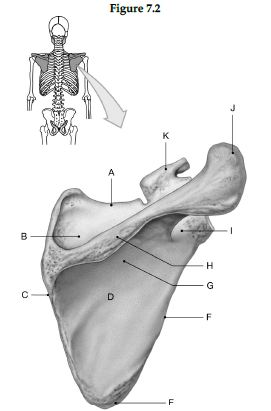Using the figure below, identify the labeled part.

1) Label A: ______________________________
2) Label B: ______________________________
3) Label C: ______________________________
4) Label D: ______________________________
5) Label E: ______________________________
6) Label F: ______________________________
7) Label G: ______________________________
8) Label H: ______________________________
9) Label I: ______________________________
10) Label J: ______________________________
11) Label K: ______________________________
1) Superior border
2) Supraspinous fossa
3) Medial border
4) Body
5) Inferior angle
6) Lateral border
7) Infraspinous fossa
8) Spine
9) Neck
10) Acromion
11) Coracoid process
You might also like to view...
Which of the following hormones regulates water permeability in the collecting duct?
A. Aldosterone B. Atrial natriuretic peptide C. Antidiuretic hormone D. Renin E. Erythropoietin
The major site of sympathetic blood flow control (resistance changes) is at the
a. arterioles b. capillaries c. metarterioles d. arteries e. veins
Which vessel carries oxygenated blood from the lung to the left atrium of the heart?
A) postcava B) pulmonary artery C) precava D) pulmonary vein
Which of the following best describes the effect that holding your breath has on blood pH?
A. Holding your breath increases blood pH by increasing the amount of carbon dioxide in the blood. B. Holding your breath increases blood pH by decreasing the amount of carbon dioxide in the blood. C. Holding your breath decreases blood pH by increasing the amount of carbon dioxide in the blood. D. Holding your breath decreases blood pH by decreasing the amount of carbon dioxide in the blood.